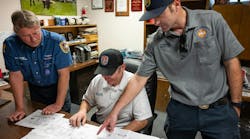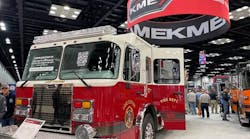After many months of effort, the fire department’s apparatus committee was given the go ahead to prepare specifications to replace Engine 3, a 1985-vintage, 1,250-gpm pumper that had provided many years of reliable service. The Village Board, after researching several options to pay for the new pumper, decided to bond for the apparatus together with other capital projects. While the fire chief was elated to finally gain approval to specify a new apparatus, the budget for the project was less than expected and established at $425,000, including any new equipment. The chief and his committee were now faced with designing a new engine to meet the needs of the community while not exceeding the amount determined by the municipal authorities.
In today’s challenging economic times, fire departments must ensure they are spending the taxpayers’ money in an effective and prudent manner, while gaining the needed components and equipment to produce a well-designed apparatus. With many communities putting off major capital projects due to economic pressures to maintain current tax rates, the cost of a new pumper may well exceed the expense for any other motorized vehicle owned by the municipality. With this in mind, the apparatus committee should first define the mission of the apparatus which will keep the specification process on task with respect to the required pump, hose, tools, equipment and parameters under which the new pumper will be designed.
Ensuring fairness
In the past, the accepted practice in many departments was to produce a set of bidding specifications that were largely influenced by one or two manufactures with some technical portions of the specifications written specifically to favor one builder. While this may have enhanced the opportunity to purchase the apparatus from a single manufacturer, it provided little assurance that the department was obtaining competitive bids for the project.
Starting with the legal boilerplate that establishes the requirements for such areas as bid and performance bonds, technical bid submissions, warranties, terms of acceptance and inspection trips, each of these issues must be written so as to not favor one bidder, but more importantly establish requirements that will protect the interests of the department. For example, when defining the requirements for payment and acceptance, the standard terms generally call for the municipality to pay in full for the apparatus upon the initial delivery to the fire department. These terms do not address the time needed to conduct an acceptance pump test, verify the apparatus in-service weight with hose and equipment as well as the designated training and maintenance classes. These specific requirements must be stipulated up front and incorporated into the final contract specifications to protect the municipality’s legal and financial interests.
Other specification language that can restrict competition among manufacturers is the use of the term “No Exceptions Permitted” in various areas of the specification. Where a department has standardized on a particular component or equipment that is available to all manufacturers such as axles, valves and emergency lighting, there is no effort to restrict competitive bids. However, requiring one specific type of chassis suspension or foam system or cab dimensions that are exclusive to one builder creates situations where the department is attempting to write out competition to the benefit of a single manufacturer.
Vehicle dimensions
Following the boilerplate portion of the specifications, which is one of the most important but also one of the most overlooked, it would be advisable to list the principal dimensions for the apparatus, including the wheelbase, overall length, overall height and other important dimensional criteria for the vehicle. It is preferable to note a range of permissible dimensions for each area to let bidders submit a proposal for a unit that most closely matches the department’s needs. If there is a maximum dimension that cannot be exceeded, such as overall height due to restrictions with the apparatus bays, then this should be specifically noted.
Stating specific dimensions such as compartment widths and clear door openings can often lead to challenges from manufacturers that can meet the overall length requirements, but with slightly different compartment dimensions. Unless there is a critical piece of equipment such as a positive-pressure ventilation (PPV) fan or hydraulic rescue tool that must be carried in a specific location, noting the minimum-cubic-foot storage capacity of each body compartment and requiring the bidder to supply all of the principal compartment dimensions, including the clear door opening, will provide an adequate basis for comparison for the apparatus committee to review.
Engine scans
Another area where performance criteria should be included in the bid proposal is requiring engine scans to validate the acceleration, grade ability and road performance of the apparatus. Given the cost of high-horsepower engine and transmission components, it may not be necessary to specify a 515-hp diesel engine for a pumper in a community with largely flat terrain and short response distances. Engine scans can provide valuable information to accurately determine the anticipated road performance for different engine and rear axle combinations. Remember, if you asked for a specific engine size and horsepower and you get it wrong, you own it. If the manufacturer puts the engine in and gets it wrong, they own it.
Over the years, departments have historically upgraded the capacity of the fire pump with each successive new apparatus. While 1,000-gpm pumps were the standard for many years, fire pump manufacturers have developed single stage pumps with common ratings up to 2,250 gpm. As centrifugal pumps are rated at draft, when fed from hydrant systems with positive intake pressure, it is possible to have a 1,250-gpm pumper produce in excess of 2,600 gpm when fed by multiple intake lines. For this reason, consideration should be given to providing sufficient large-diameter intakes on different sides of the apparatus with appropriately sized short sections of five-inch supply hose to provide heavy fire streams when required.
Rarely do pumpers maximize their rated capacity or are limited by horsepower to provide adequate fire flows at major incidents. When required to provide large-caliber streams, engine apparatus is much more dependent on the available residual pressure and flow from the water system than being limited by the rating of the fire pump, whether single- or two-stage design.
Listing components
At some point in the specifications, it will be necessary to list the various major components on the apparatus, including frame, engine, transmission, fire pump, water tank, cab and body, piping, paint and aerial device on ladder trucks to identify the various warranties along with the requested time period for each component. This is an area that is often overlooked as manufacturers will supply their standard warranty terms that are included with the apparatus purchase. Each of the requested component area should be accompanied with specific statement of warranty from each bidder which should clearly identify any limitations or exclusions regarding repair or replacement of the part.
Body and paint warranties in particular will have stipulations regarding the extent of warranty coverage and the time frame provided when repairs would be completed at no cost to the department. For example, it is not uncommon to read through a 10-year paint warranty to find that issues with respect to corrosion and paint adhesion are fully covered only for the first three years and are pro-rated after that point.
Conclusion
Writing apparatus specifications can be a long and painstaking process. The details that are incorporated in the final bid documents, however, can go a long way to provide the department’s apparatus committee with the necessary legal and technical submissions to review and analyze during bid evaluations. The slogan of a well-known clothing store said it best: “An educated consumer is our best customer.”






